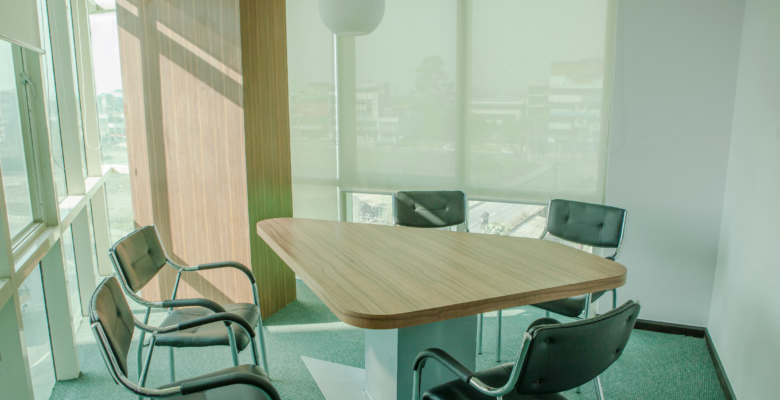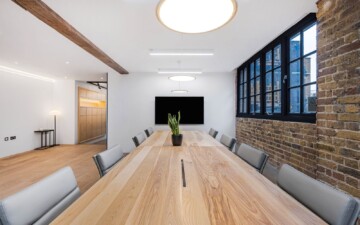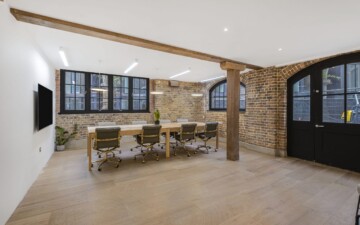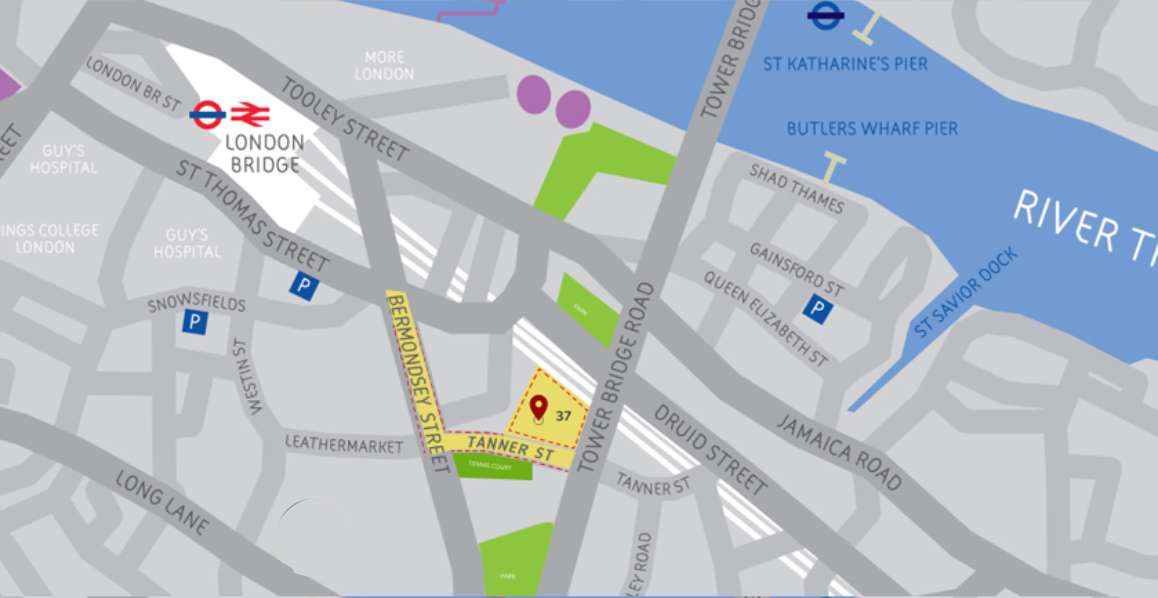Over the past decade, the work environment has undergone significant shifts, with remote and flexible working arrangements becoming more prevalent. Open-plan office layouts in shared workspaces are rapidly gaining popularity.
While open offices address the evolving needs of employees, they pose certain challenges for collaborative work, such as noise and frequent disruptions. As a response, there’s a marked shift towards new-age collaborative spaces. These spaces, known as huddle rooms, are gradually replacing traditional conference rooms.
Huddle rooms play a pivotal role in enabling interactions and collaborations. They offer a respite from the open environment, providing small teams with a dedicated area to focus on collaborative tasks. Whether it is a spontaneous brainstorming session or a quick team meeting, huddle rooms offer the privacy needed to enhance productivity in the midst of an open office layout.
This article discusses how businesses can boost collaboration at their workplace by creating an office huddle space that meets all their needs.
What is a Huddle Room?
The term “huddle room” was inspired by sports teams coming together for brief on-field huddles to strategise and align their gameplay. Similarly, a huddle room in an office provides a space to regroup quickly and informally as an alternative to a scheduled meeting in a larger conference room.
Huddle rooms are beneficial for hybrid workplaces as they can be equipped with video collaboration technology like a display, webcam, microphone, and speaker to allow teams to connect with remote colleagues. Typically, huddle rooms fit 2-6 people, as the aim is to enable key team members to catch up and collaborate as a project unfolds in real time.
For example:
In a huddle room, it could be as simple as 2-3 individuals collaborating at a table, often extending to a few more in-person, with the option for several others to join virtually. Given the limitless potential for remote participation, accommodating up to 20 participants in a hybrid format becomes feasible, revolutionising our perception of huddle room capacities.
It is perfect for brief updates, quick group brainstorming sessions, stand-ups, or spontaneous calls with those working remotely, huddle meetings are versatile, supporting both in-person and hybrid interactions.
What are the Features of Huddle Room?
A huddle room is equipped with the following features:
- It is designed for small group collaboration (2-10 people).
- It should be equipped with video conferencing technology and device connectivity.
- It should support presentation tools for sharing content.
- It should have flexible seating arrangements for informal meetings. It features a simple setup with a small table and chairs for quick, efficient meetings.
- The design emphasises on functionality, simplicity, and adaptability, allowing for immediate use without extensive setup.
How Big is a Huddle Room?
The size of an office huddle space largely depends on how big your team is. Ideally, huddle rooms are designed for 2-6 people. They can be up to 100-250 square feet or bigger, depending on the purpose of your meeting.
In case you have limited office space, you can employ creative solutions, like converting nooks, corners, or open areas into huddle meeting rooms using furniture, plants, whiteboards, or glass walls. An important factor to consider when allocating space for huddle meetings in your office is to ensure that there is enough area to accommodate comfortable seating, a small table or standing area, and built-in or freestanding AV equipment.
What are the Benefits of Office Huddle Space?
Huddle rooms offer numerous advantages for organisations seeking to optimise teamwork and productivity. Here are some key benefits:
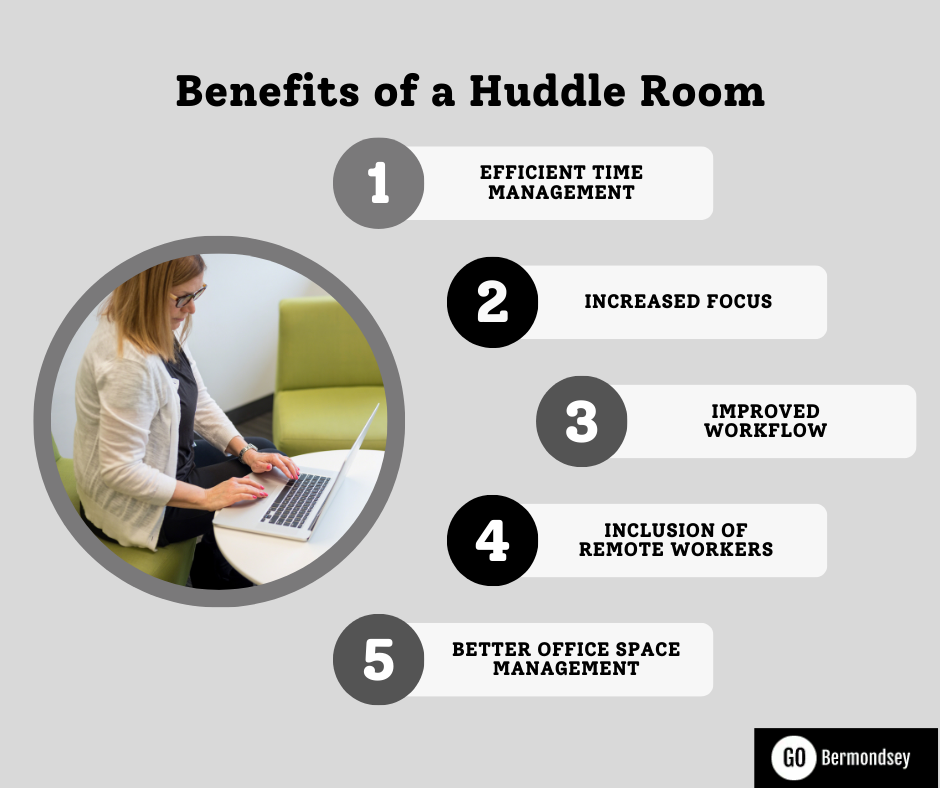
-
Efficient Time Management
Studies suggest that up to 40% of employees waste up to 30 minutes searching for a collaborative space for meetings. Along with larger conference rooms, companies can provide multiple smaller huddle spaces distributed throughout the office. This allows employees to easily find and utilise these spaces for impromptu meetings, reducing the time wasted in searching for or booking suitable collaboration areas.
-
Increased Focus
Employees can interact better in a secluded, quiet space than at busy work desks. Huddle rooms provide a relaxed and serene environment for small mid-work discussions, improving focus on the task at hand. This can improve the quality of your meetings and increase productivity.
-
Improved Workflow
Huddle meetings allow your team to discuss new ideas, questions, or changes in the workflow promptly. They do not have to wait for the next formal meeting to share their thoughts or to brainstorm on an ongoing project. These interactions help troubleshoot and solve problems quickly, resulting in a more efficient workplace.
-
Inclusion of Remote Workers
Office huddle spaces are versatile and perfectly suited for modern-day hybrid work arrangements.Video-enabled huddle rooms make it easy to include remote colleagues for impromptu meetings.
-
Better Office Space Management
The Wall Street Journal reports that 73% of office meetings require small teams of 2-4 people. However, 53% of office conference rooms are designed for more than seven people, indicating inefficient use of limited space.
Dividing a large conference room into smaller huddle spaces will help in better office space management. Implementing this technique will help you utilise your office space more productively.
Huddle Room Vs. Conference Room
While both spaces are essential, huddle rooms and conference rooms serve distinct purposes. Here are the differences between the two:
| Aspect |
Huddle Rooms |
Conference Rooms |
| Size |
Accommodates 2-6 people |
Seats 6-20+ people |
| Location |
Utilises small spaces |
Typically encompass large spaces |
| Purpose |
Informal discussions, spontaneous collaboration |
Formal, scheduled meetings, presentations |
| Technology |
Compact, all-in-one video devices |
Robust AV systems, multiple screens |
| Demand |
Higher demand for daily meetings |
Typically booked in advance |
| Availability |
Can be booked immediately |
Limited and requires advance scheduling |
What Makes a Good Huddle Meeting Room?
When optimised with these 6 key features, huddle rooms become the ideal go-to spaces for productive team collaborations:
- Video Conferencing: Huddle rooms must be equipped with proper video conferencing devices to include remote team members, facilitating discussions and presentations in a hybrid work setting.
- BYOD Connectivity: Ensure Bring Your Own Device (BYOD) compatibility so that any laptop or mobile device can instantly connect and share content with the room display system.
- Security: Prioritise privacy and security measures in the huddle room to keep conversations confidential.
- Comfortable Furniture: The furniture in the huddle rooms should be comfortable.
- Ambience: To promote comfort and focus during huddle meetings, add plants and let in natural light into the huddle spaces.
- Writing Surfaces: Provide whiteboards or glass walls in the room for brainstorming ideas and to aid visualising concepts.
How to Integrate Huddle Rooms with Remote Work?
To integrate huddle rooms with remote work, ensure to:
- Equip with advanced video conferencing tech for clear audio/video.
- Use collaboration tools for real-time document sharing/editing.
- Choose software compatible with your company’s workflow.
- Train staff on hybrid meeting best practices for inclusivity.
- Ensure technology supports both in-room and remote participation.
- Adapt room design for easy use by both physical and virtual attendees.
Do you know? Approx. 86% of business leaders and employees identify inadequate collaboration as the primary cause of workplace failures.
Who Should Book a Huddle Room?
Huddle areas fulfil everyday meeting and collaboration needs for the modern workforce.
Any team that wants to break down barriers to communication and collaboration will gain from huddle rooms. For instance, managers can utilise huddle meeting rooms for quick one-on-one check-ins with team members, in addition to formal performance reviews. Sales, marketing, and customer service teams that regularly interact with clients will find huddle rooms useful for impromptu strategy meetings, before and after client calls.
Huddle rooms promote collaboration between employees from different departments for impromptu meetings and quick sync ups to share insights.
Best-in-class Office Spaces for Every Business
Book a visit and choose a office workplace that suits your team size
Why Should You Use Huddle Rooms?
Huddle rooms serve multiple purposes in supporting collaboration:
- Brainstorming: The huddle room environment encourages teams to tap into their creativity. The space facilitates spontaneous innovation sessions.
- Hybrid Meetings: Video conferencing technology enables small groups to connect in-person and include remote participants.
- Phone Calls: Huddle rooms provide privacy for individual calls, offering a quiet space away from noisy open office areas.
- One-on-One Meetings: The intimate setting allows managers to conduct one-on-one meetings with team members or clients.
- Stand-Up Meetings: Huddle rooms are perfect for quick daily team meetings.
How to Choose a Huddle Space that Increases Productivity?
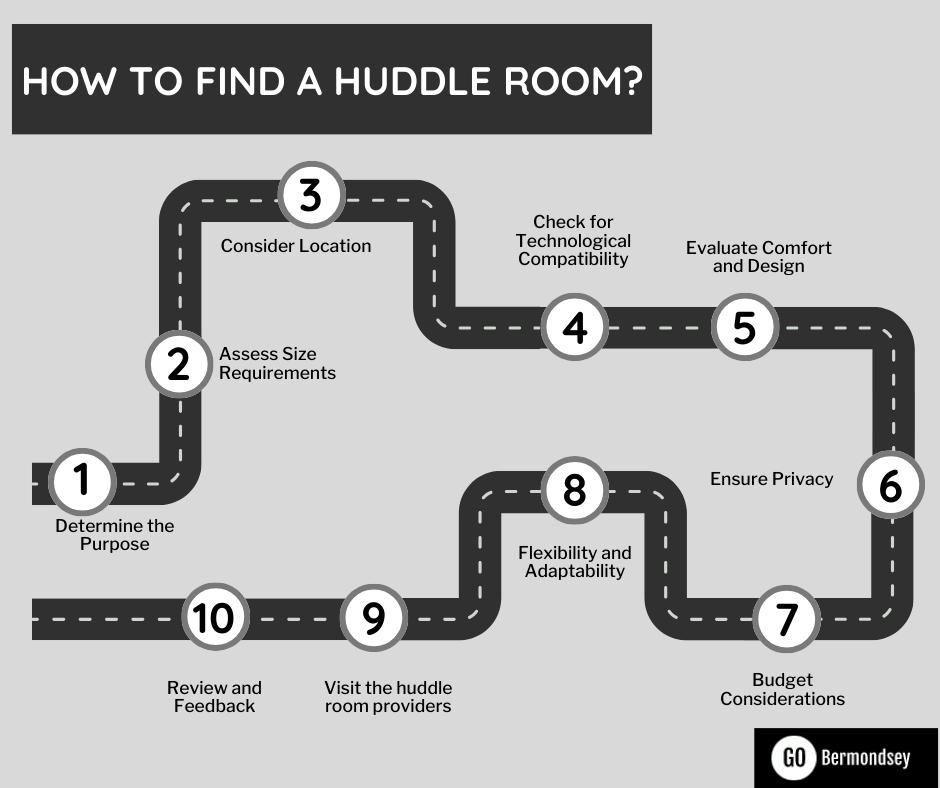
When choosing huddle spaces to enhance productivity, avoid selecting cramped rooms that feel closed-in. Instead, seek out spaces with natural light, which can boost focus and energy levels.
Opt for spaces that are outfitted with essential video conferencing technology like displays, web cameras, microphones and charging ports for seamless virtual meetings. You can also add whiteboards and writing walls so collaborators can easily share ideas during the meetings.
Most importantly, connect with your team to understand their needs for an effective huddle space. Conduct a survey on layout requirements, tech capabilities, and design elements that would best facilitate collaboration. The goal is to create dynamic huddle spaces that can transform and adapt, as collaboration needs may change over time.
With strategic planning centered on input from your team, these compact huddle rooms can make a significant impact on productivity.
What is the Cost of Hiring a Huddle Room?
The hourly rate for a huddle meeting room can be anywhere between £20 to £200 per hour. Rental prices in London vary depending on the specific location, the type of venue, the amenities offered, the duration of the booking, and the number of participants.
Emerging Trends in Huddle Room in 2024
Emerging trends in huddle room design for 2024 focus on immersive experiences, AI integration, and flexibility. Virtual reality technologies, augmented reality solutions, and AI tools like smart assistants and intelligent cameras are becoming standard to enhance collaboration among distributed teams. Additionally, the need for flexibility is addressed by equipping rooms with tools adaptable to various workflows and team sizes, supporting hybrid and remote participation. These trends are reshaping huddle rooms into more inclusive, efficient, and technologically advanced spaces for collaboration UC Today
How Can GO Bermondsey Help?
GO Bermondsey provides an optimal setting for hosting productive huddle meetings and spontaneous collaborations. We offer meeting rooms of all sizes to accommodate the needs of both large and small teams with secure and lockable rooms. Each of our rooms is uniquely designed and equipped with state-of-the-art technology, including high-speed internet and audio-visual equipment for seamless collaboration. For your next huddle meeting, look no further than GO Bermondsey, located at Tanner St. for a conveniently located and well-equipped space designed to spark productivity. Visit our website for more details.
